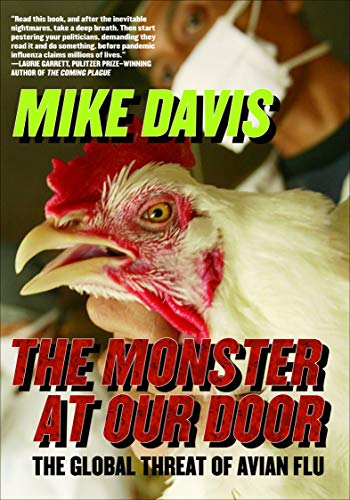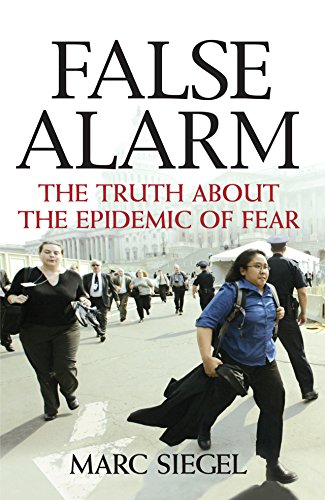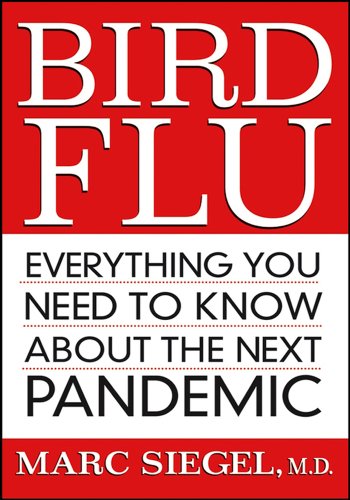The Birds Is Coming!
The Monster at Our Door: The Global Threat of Avian Flu
Mike Davis. 2005. The New Press, New York. 212 pages.
False Alarm: The Truth About the Epidemic of Fear
Marc Siegel, M.D. 2005. John Wiley & Sons, Inc., Hoboken, New Jersey. 246 pages.
Bird Flu: Everything You Need to Know About the Next Pandemic
Marc Siegel, M.D. 2006. John Wiley & Sons, Inc., Hoboken, New Jersey. 202 pages.
Do you remember when Alfred Hitchcock’s The Birds went on public release? Many people first learned of the movie through a highly effective poster campaign that carried the simple but enigmatic warning, “The Birds Is Coming.” It caught people’s attention, partly, of course, because the grammar appeared to be wrong.
Hitchcock’s fatalistic flick dealt with out-of-control birds taking over a community. Well, it seems the birds are back! Except now the birds are dying in large numbers as a result of a virulent strain of avian flu, or through preventive culling. The worry is that birds may spread their flu to humans, and then humans may spread it to fellow humans and kick off a full-blown pandemic of incalculable disruption and devastation.
Although the media headlines don’t seem to be screaming at us with the same volume and regularity as a few months ago, the fear that the monster of a flu pandemic is hammering on our door, just waiting to spring across the threshold to engulf us, is still widespread. Scary comparisons are made with the worst pandemic in recorded history, the 1918 outbreak of Spanish flu, when between 30 and 100 million people around the world are thought to have perished in just a few months. That devastating flu bug is now known to have originated in birds, raising concerns that the current strain of highly pathogenic avian influenza might become a brand new strain of deadly human disease and claim the lives of multiple millions.
All this begs a fundamental question: Are we being told the truth about the threat of a global pandemic, or is it overblown to create fear and bolster the reputations of hard-pressed governments, swell the coffers of health-care agencies, and create even more profits for the pharmaceutical industry? Where does the balance lie in communicating such threats? Too little information breeds complacency and lack of preparedness. Too much can cause quite unnecessary fear and panic, which leads to cynicism, anger, and finally disbelief as long as the pandemic fails to materialize.
We explore these important issues through two authors who address themselves to different aspects of a potential flu pandemic. Mike Davis and Marc Siegel have written compelling books that come from starkly opposing viewpoints. Davis reasons generally from all the disturbing facts relating to global flu and wants to stimulate us to specific action; Siegel, as a medical doctor, reasons from specific local experience in his New York practice: he sees all the unwarranted and excessive fear about the flu stirred up generally in his patients and wants to calm them down—and us too.
Which author’s view represents the wiser approach, or are the two in fact compatible?
Prophet vs Physician
Davis, described variously as “a brilliant maverick scholar” and “a prescient Marxist prophet of end-of-the-continent doom and gloom,” catalogues a dizzying and often disturbing welter of information. He uses hyperbolic language to engage our emotions, and we are in turn shocked, dismayed, frightened, angered and outraged by a litany of stories outlining human ineptitude, corruption, ignorance and incompetence. His motivation, fueled by his admitted Marxist ideology, arises from his conviction that “our government and others [have failed] to protect the world from the imminent danger of an almost unfathomably dangerous influenza outbreak.” He warns that “the hour hand on the pandemic clock ominously approaches midnight. . . . Now, with a real Monster at our door—as terrible as any in science fiction—will we wake up in time?”
“The World Health Organization warns that [H5N1] is on the verge of mutating into a super-contagious pandemic form that could visit several billion homes—and kill up to 100 million people—within two years.”
Siegel, on the other hand, a practicing New York physician, wrote False Alarm in the wake of the September 11 destruction of the World Trade Center. In the months that followed, he became increasingly troubled by the “newfound vulnerability” of the American public. “We grew afraid more easily than before, misinformed by our leaders and provoked by the news media.” Siegel believes that health-care issues in America are “blown out of proportion to the real danger,” and his aim is “to try to offer perspective and a salve of reassurance” by explaining the nature of irrational fears and how they can be combated. In Bird Flu, Siegel takes issue with what he sees as excessive hysteria whipped up by the media and so-called experts, and he passionately wants us “to see bird flu as the theoretical threat it is in the larger context of disease and public health.”
Apocalyptic Superlatives
The cover of Davis’s polemic evokes a feeling of the sensational movie trailers from the 1950s. The dustcover proclaims that “avian influenza is a viral asteroid on a collision course with humanity,” “a viral apocalypse in the making.” This is heart-stopping, lurid writing at its best. Some readers will find themselves emotionally unable to deal with such language—no doubt just the sort of unwarranted discourse Siegel objects to? As the book unfolds, Davis describes the virus with such phrases as “unfathomably dangerous,” “nightmarish virulence,” “most ferocious of man-eaters,” “extraordinary shape-shifters,” “stunning evolutionary capabilities” and “the next great pestilence.” Though his stated motive is simply to spur officialdom to concerted action before it is too late, one is bound to wonder what degree of hype might be involved, especially because he has been taken to task over his somewhat creative and selective use of facts in earlier works.
“Davis is the first to admit that he won’t let a fact get in the way of a good story. . . . The point is less what he discovers than which parts of the record he chooses to look at.”
For example, assuming the maximum (though by no means widely accepted) figure cited for the 1918 pandemic of 100 million fatalities worldwide, Davis extrapolates to today’s world population and arrives at an equivalent of 325 million likely fatalities from the current virus. He then expands his extrapolation, claiming that with the virulence of H5N1 it could yield a worst-case scenario of 1 billion dead. Mortality on such an inconceivable scale would place this flu firmly in apocalyptic territory: the book of Revelation pictures the Four Horsemen of the Apocalypse, combining ideological wars, famines and diseases, and killing one fourth of humanity.
Davis explains the essence of the avian flu threat in sensational terms: “A mutant influenza of nightmarish virulence—evolved and now entrenched in ecological niches recently created by global agro-capitalism—is searching for the new gene or two that will enable it to travel at pandemic velocity through a densely urbanized and mostly poor humanity. This is a destiny, moreover, that we have largely forced upon influenza. Human-induced environmental shocks—overseas tourism, wetland destruction, a corporate ‘Livestock Revolution,’ and Third World urbanization with the attendant growth of megaslums—are responsible for turning influenza’s extraordinary Darwinian mutability into one of the most dangerous biological forces on our besieged planet.” He sees our modern vulnerability exacerbated by urban poverty, the pressures caused by fast-food industries, corrupt and inept governments, neglect of vaccine development, and the deterioration or collapse of national public-health infrastructures. All these themes are examined in detail throughout his book.
Let’s Calm Down
Siegel’s two books are closely related to each other in their themes. False Alarm is about what he sees as the unwarranted fear that was triggered throughout American society by the September 11 terrorist atrocity in his home city. He rails at unreal threats that are hyped by media and government. He sees the results in his practice: fearful, neurotic patients in great need of reassurance and a sane-minded reality check. This book is a concerned plea from a committed community doctor to stop overplaying risks to society that only stir up excessive worry and fear, which he and others then have to deal with.
“How many of us listen to somber-toned newscasters and expect that what we are hearing is valid information? Many of us grew up believing we could find truth in the news.”
Siegel divides his material into three parts. In the first section he effectively discusses the chemistry of the flight-fight response and the impact of fear. He then discusses various diseases, contrasting the numbers of those affected by malaria, dengue and AIDS with the numbers of those affected by anthrax, SARS, West Nile virus, mad cow disease and smallpox. Siegel is concerned that the funds for combating known killers will be diverted to fight the specter of a disease which may never appear. He concludes with a section on how to resolve our fears, giving examples of how fear can itself make people sick. Despite the threats, he claims that Americans have never been safer, with life spans 60 percent longer in 2000 than in 1900, and with the odds of being killed in a terrorist incident in 2002 put at 1 in 9 million. In contrast, he cites the odds of dying in a traffic accident at 1 in 7,000. Yet Americans still feel afraid, and “if our fears aren’t real,” he says, “we invent them.”
Siegel’s experience amounts to a sad commentary on American society, politics and media. He sees a fear-obsessed, overly medicated society of hypochondriacs, materially pampered, yet living in fear of illness and death, and dominated by unrealistic concerns that are excessively played to by media and government. “In twenty-first-century America, we worship the god of wealth. We medicate ourselves with the emotional anesthesia of materialism, but our fears seep in and overtake us anyway.”
And this doctor’s advice? “To conquer fear we must return it to its primitive place as an instinct. We must stop overpersonalizing it. We must regain our footing with regular sleep, regular meals, regular entertainment, regular exercise, and regular work. We must resist those who choose the wrong danger, hype the need to respond, and then bungle the response—making the threat seem even more real. We must replace our unreal fears with real courage.”
Siegel points out that other nations are not nearly so obsessed with health issues: they manage to react to their circumstances with a great deal less fear, despite the fact that some face an almost constant threat of terrorism or other major disruption.
The first half of Siegel’s second book, Bird Flu, focuses on sorting out the facts of bird flu from the fiction. He then examines how the United States has arrived at its unhealthy levels of fear. He advocates replacing fear with courage and worry with faith: “Faith takes the worry away and transfers it to a higher Being who is controlling the world. Any sense of control we have is illusory.” His concluding comments effectively sum up his book: “What bothers me most as a physician is that I see my patients being harmed, and there’s little I can do to stop it. Fear is infectious, and the fear of bird flu has become particularly virulent. There is a vaccine for this fear: it is called information mixed with perspective. Since there is a shortage of this vaccine, fear has begun to spread throughout my community and yours. That is a chilling foretaste of the horror of a true epidemic.”
To Hype or Not to Hype?
Davis’s book contains a comprehensive notes section, which is especially useful for the reader who wants to look deeper and separate fact from hyperbole. The Monster goes into greater detail than Bird Flu, as Davis describes the intricacies of the influenza virus and the shortcomings of dealing with it. But Siegel’s Bird Flu also does a creditable job of laying bare the basics of the illness. In addition, he offers a comprehensive and helpful question-and-answer section and ends with a thorough bibliography. The book lacks an index, however, which is a pity—perhaps a result of his rush to get it into print only months after False Alarm (various chunks of Bird Flu are acknowledged as having appeared in False Alarm as well).
Neither author seems aware of the other’s material. Each would undoubtedly benefit from such contact for the different perspective provided. We should wish Siegel every success in helping to combat irrational fears. His point is well taken: we should not fear excessively, as that can only do more harm than good. And we are certain that Davis, given his history as a political activist, will continue his combative crusade to stimulate officialdom to more effective action.
Different as their viewpoints are, Davis and Siegel agree that U.S. Homeland Security funding to combat bioterrorism in response to the World Trade Center attacks has been misallocated: planning for threats like smallpox or anthrax has taken precedence over research and planning for malaria, tuberculosis and influenza. Why spend billions on hypothetical threats, they ask, when far greater and more likely threats are looming, with not nearly enough being done at either the national or global level to confront them? Both express hope that we can learn from our past mistakes in this area.
Davis and Siegel agree on another point: both feel the public has been misled by government and the media. But while Siegel believes the facts are overstated, Davis, whose passionate pleas are noticeably inflamed by his political views, takes to task the highest levels of government for downplaying the magnitude of the problem.
Both authors are right to be concerned. Governments, health-care agencies and drug companies need to get their collective acts together and become more effective if the world is to be properly prepared for a pandemic that may indeed be imminent. On the other hand, people need to take personal responsibility and do what they can on an individual level instead of expecting the government to do everything for them. At the very least, people need to control their very human fears of threats that are not yet a reality and may never be.
A Balanced Response
To return to our original question: Davis himself asks whether WHO has exaggerated the threat of H5N1 avian flu, although by this point in the book, it is clear to the reader what his answer will be. Because of all the factors he outlines, he concludes that various subtypes of the flu virus are “slouching towards Bethlehem with bright prospects of producing pandemic offspring. All the major candidates, in addition, appear to be increasing their evolutionary fitness to spread rapidly through new avian and mammal species. . . . Even if humanity miraculously dodged H5N1, we would soon be under threat from other virulent avian subtypes.”
As both authors and other experts acknowledge, the threat isn’t only from H5N1 but from the flu bug’s capacity to rapidly mutate and reassemble in different forms, aided and abetted by unwitting human interventions. Davis’s biting criticism of the state of world public health preparedness evokes memories of a previous iconic disaster: “In the face of the peril of avian influenza, as with HIV/AIDS earlier, world public health resources are organized rather like the lifeboats were on the Titanic.”
If these statements are true, then Siegel at times seems to border on the complacent, not fully aware of the seriousness of the threat, merely reacting to the more neurotic occupants of his waiting room and excessively talking up the problem of fear. Or are we overhyping the threat after all? Is Siegel right in alleging that this kind of language only stokes up unnecessary fears? So far in 2006, the number of human cases of bird flu has not risen dramatically, defying the doomsday prophets who had anticipated a rapid spread of the disease with this year’s annual avian migration. Does this signal the end of the story? Only the fullness of time will tell.
In the meantime, while we wait to see whether the birds really are coming, let’s be sure we mount the best-informed and most effective response, and don’t fly off into an unnecessary epidemic of fear that in the end may do more damage than the flu itself. Perhaps we should pray that we get the substantive health care and emotional balance right, replacing fear with courage and worry with faith, so we are ready if the ogre of another flu pandemic should rear its ugly head.



